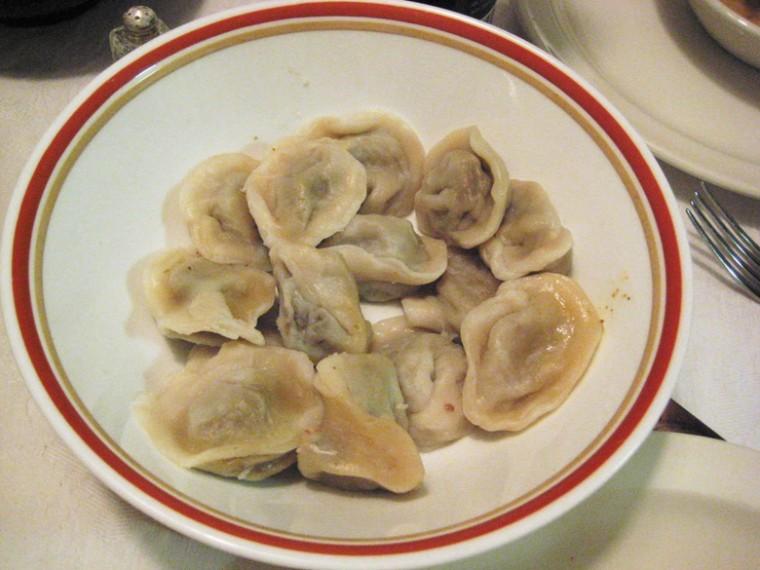Sukkot food: Get stuffed
Published October 12, 2011
Sukkot is here and like most Jewish holidays, it’s time to get stuffed. But I’m not just talking about the revellers. I’m referring to the foods themselves. Sukkot – along with Hoshana Raba and Simchat Torah – has an interesting relationship with stuffed foods.
Why the connection? Rabbi Mark Hurvitz offers this culinary metaphor. Sukkot “includes the notion of welcoming guests (both living and historical heroes) into the sukkah, thus ‘stuffing’ them into a wrapper of sorts.” [http://bit.ly/stuffed01]
Ruth Heiges suggests stuffed vegetables are like “miniature cornucopia symbolizing the plenty with which we have been blessed and for which we hope throughout the coming new year.” [http://bit.ly/stuffed02]
In succulence for Sukkot and Simchat Torah, Gil Marks writes that “Stuffed vegetables – a most ancient Sukkot dish, probably having its genesis with the grape leaves remaining on the vine after the harvest that were then filled and simmered until tender – are common sights on holiday tables in all communities. As there were few or no grapes in much of Northern and Eastern Europe, the prevalent cabbage became a handy substitute.” Marks includes recipes for Yaprakites de Peshe (Greek Fish in Grape Leaves), Zarkhop (Bukharan Lamb Stew with Vegetables) and Inferike (Syrian Meat and Potato Casserole). [http://bit.ly/stuffed03]
Browse through the Sukkot section of one of the premier Jewish cooking sites and you’ll find dozens of recipes for stuffing just about any vegetable – and fruit – you can think of: squash, zucchini, artichokes, eggplants, avocados, tomatoes, beets and dates. And of course, the cabbage. [http://bit.ly/stuffed04]
Lovers of stuffed cabbage may encounter a semantic barrier as they surf for a favorite recipe. “Philologos,” the linguistic columnist for The Forward, did an entire piece on how your name for that food depends on where your family hails from. Letter writer Milton Lasky responded, “Whether you call it prakas, golubtzi, holubtsi, holeptshes, gulomkes, oleshkes, or whatever is really immaterial. My Mother of ‘Blessed Memory’ called it ‘gevilkte cabbage’ (rolled cabbage) and that was good enough for me providing what was rolled into the cabbage leaves.” [http://bit.ly/stuffed05]
And who could ever imagine that the lowly cabbage roll could be the source of marital friction? Blogger Miriyummy isn’t afraid of working hard in the kitchen. She hasn’t bought a challah in almost a decade. But oh the time and effort to make cabbage rolls. Miriyummy has always favored the simpler “Unstuffed Cabbage” (and provides a recipe). But then marriage came along and a husband who “thinks unstuffed cabbage is an abomination. He had it once at my house while we were dating, and decided to quote Rabbi Meir Kahane and say ‘Never again!'” The solution? ” He makes his own stuffed cabbage and that is the only kind allowed in his sukkah.” [http://bit.ly/stuffed06]
If the filled food tradition appeals to you but you are looking beyond cabbage rolls for your festive dinner, you do have some untraditional options. “Try meat-stuffed tomatoes, pesto stuffed mushrooms, cheesy stuffed zucchini (the round ones are astonishing for stuffing), and baked stuffed nectarines for desserts. … Strudels are an additional one difference on the stuffed theme – you can take this in many separate directions – stuff with meat, sautéed eggplant and mushrooms, tuna, or fruit.” [http://bit.ly/stuffed07]
Another filled food associated with the holiday is kreplach, dumplings traditionally eaten on the seventh day of Sukkot, Hoshana Raba. Hoshana Raba is when each person’s judgment that had been written on Rosh Hashana and sealed on Yom Kippur is finally handed over to the angel – giving us one last chance to repent. [http://bit.ly/stuffed08] So what’s the connection to the humble kreplach? The Nishmas site suggests that judgment (symbolized by meat) is clothed in kindness (symbolized by the dough). [http://bit.ly/stuffed09]
In fact “The word, ‘KRePlach’ is Yiddish and is said to be derived from the Hebrew names of holidays on which this food is eaten: Before or after Yom [K]ippur , Hoshana [R]aba and [P]urim. These holidays are connected to each other because they involve some sort of striking or beating: On Yom Kippur we beat our heart in prayer; on Hoshana Raba we beat willow branches, and on Purim, we beat (and blast and cream and clobber) Haman.” [http://bit.ly/stuffed10]
Now that you know the reason, you can take your pick of 13 kreplach recipes in the Jewish Food Archives including beef, chicken liver, kasha, bite-sized and cheese. [http://bit.ly/stuffed11]
Have a very ful-filling holiday.
Mark Mietkiewicz can be reached at [email protected].














